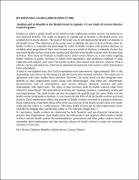| dc.description.abstract | BYAMUKAMA AGABA (2008-03-HSM-FT-006)
Dualism and its Benefits to the Health Sector in Uganda: A Case Study of Luwero District, Central Uganda
Dualism is where a public health sector health worker undertakes another activity for financial or non-financial benefits. This study on dualism in Uganda and its benefits in the health sector was conducted in Luwero district. The goal of the study was to demonstrate the benefits of dualism in the health sector. The objectives of the study were: to identify the type of dual activities done by health workers, to calculate the percentage by cadre of health workers who practice dualism, to establish what proportion of their total income was as a result of dualism, to identify factors that motivated health workers to practice dualism and the time when health workers went for their dual activities. This study on Dualism in health sector used Luwero district as a case study targeting health workers in public facilities in which both quantitative and qualitative methods of data collection and analysis were used. The health workers interviewed were doctors, medical clinical officers, nurses and midwives. Interviewer administered questions were used to collect information from respondents.
A total of one hundred sixty five (165) respondents were interviewed. Approximately 38% of the respondents were driven by the monetary and the rest by non-monetary benefits. The results are in agreement with other studies done elsewhere. However, the study found out that alongside these benefits of dual employment comes along with disadvantages. And these are: absenteeism, burnout/stress, lack of concentration, poor service delivery, domestic violence and poor relationships with supervisors. The types of dual activities done by health workers range from clinical to non-clinical. The non-clinical activities are: farming, business, consultancy works and teaching/training. The study found out that the higher the qualification the more likely will the health worker participate in dualism. It was found out that 85% of all the health workers practiced dualism. Dual employment affects the income of health workers involved in a positive direction. Dual employment contributes about 69% of the total income of the health workers that were under study and this makes it a viable practice. The times health workers go for dual employment varies with 88.5% dodging duty unofficially while 11.5% officially dodge duty. 5
In conclusion, health workers are motivated by both financial and non-financial incentives to practice dual employment. Dual employment has both positive and negative effects both to health workers and the health system. Recommendations: government and other policy makers need to streamline dual employment and also increase salaries of health workers to meet the economic situations of the time.
Key Words: Dualism, Benefits, Health Sector, Luwero District | en_US |


